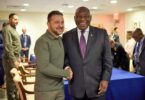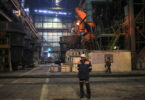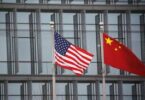Emanuele Ottolenghi
Iranian presidential elections have rarely mattered. Both the past victory of the so-called reformists and now the restoration of a tailor made presidency to consolidate the regime, portray something similar to the hangman word game, where one has to guess the word an opponent is thinking of, before the gradual drawing of a stick figure condemned to the gallows.
On June 18, 2021, Ebrahim Raisi was elected as the next president of Iran. Western observers routinely wonder how presidential elections might impact Iran’s regional posture and nuclear talks. In fact, results have rarely mattered.
Regardless of who’s president, Iran has been on a steady path to nuclear weapons’ capability, regional hegemony, and support for terrorism since its 1979 revolution. This time is no different. Raisi was selected – and his access to the presidency engineered – to ensure regime consolidation and continuity, as Iran faces both unprecedented challenges and opportunities.
Regime Consolidation. The elected institutions of the Islamic Republic no doubt fulfill a more meaningful role than rubberstamp parliaments in other authoritarian regimes such as Syria, but the president of Iran does not have the last word on the key foreign policy and national security issues that concern Western capitals. Raisi is no different. In fact, his track record suggests this time there will be an even closer alignment between the elected presidency and the unelected, clerical hierarchy ruling Iran.
Raisi is a lackluster cleric, whose main claim to fame is his membership in the death commission charged with sending thousands to their death in the summer of 1988. As Iran was emerging from the Iran-Iraq War, its late, and by then ailing Supreme Leader, Ayatollah Ali Khomeini, instigated a purge of political dissidents, both real and imaginary, that led to the systematic slaughter of thousands inside Iran’s prisons, including political prisoners as young as thirteen.
Not only did Raisi play a key role in the 1988 massacres. As the deputy head of Iran’s judiciary in 2009, he also supervised the brutal repression of pro-democracy activists that followed that year’s elections. Promoted to the role of chief of the judiciary in 2019, he further oversaw the repression of dissent that led to at least 1,500 documented deaths in November 2019, as protests erupted once again against the regime.
In short, Raisi is the Islamic Revolution’s hangman. His entire career in office, as a powerful figure of Iran’s judiciary, is associated with the regime’s repressive apparatus, something which earned him U.S. human rights’ sanctions under the Trump Administration. He also ran, from 2016 to 2019, the powerful Astan Quds Razavi religious foundation, a business empire centered around the Shi’a religious shrine of Mashad, which feeds directly into the discretionary funds of the office of the Supreme Leader. He has the power of the purse, the sword, and now, the crown.
As a faithful executioner of the regime’s revolutionary vision, he will be the Supreme Leader, Ali Khamenei’s yes man, and in a privileged position to groom himself as his successor when the time comes. Khamenei is in his eighties and in poor health. He wanted a regime loyalist to take the presidency so as to secure the regime powerbase and avoid the risk of a power vacuum were he to die.
In the past, Iran’s leaders took some calculated risks with elections – most notably in 1997, when they allowed a reformist candidate, Mohammad Khatami to win. The regime has used elections in the past to balance different power centers and offer a safety valve to its restive population by creating the illusion of democratic empowerment through the ballot box. The circumstances were very different though and even then, Khatami was not a man to challenge the repressive apparatus when protests erupted for more radical change than he was willing to contemplate. Nevertheless, the possibility of divergence between an elected office and the clerical guardians of the revolution has always been there, especially as figures like the late Rafsanjani – president between 1989 and 1997 – moved into the presidential office from a strong clerical and financial powerbase and impeccable revolutionary credentials.
Ultimately, elections serve the goal of ensuring regime legitimacy and its long-term survival. This time, with both unprecedented challenges and opportunities at its doorstep, and the specter of a power vacuum looming on the horizon, the regime took no chances and ensured these elections would largely be an elaborate pageant with a pre-established outcome.
Raisi did not win a popularity contest – the turnout was at its lowest in the short history of the Islamic Republic, below 50 percent. And many of those who did vote cast a blank ballot to express their anger at the lack of real choice. In short, Raisi barely won the hardcore loyalist base of the regime.
Nothing changes then. Raisi will likely preside over the country’s transition from Khamenei’s reign to his successor – who could turn out to be Raisi himself. That, more than anything else, is the significance of last month’s elections.
Sanctions relief, regional challenges, and nuclear talks. It is likely, though by no means guaranteed, that by the time Raisi takes office in August, the Vienna talks will have yielded a new nuclear deal. Under such circumstances, Iran will resume compliance with the 2015 Joint Comprehensive Plan of Action, or JCPOA, and the United States will lift sanctions reimposed by the Trump Administration after May 2018.
There are numerous uncertainties still governing negotiations and their outcome. Assuming the talks yield a result, Raisi will preside over Iran’s return to international finance and business. Global economic prospects in the months ahead signal fast economic growth as the global economy rebounds from the COViD-19 pandemic. That includes an already detectable spike in oil prices, as industrial production and global travel quickly return to pre-pandemic levels. Iran’s oil sales this year, despite ongoing sanctions, already show promise for its beleaguered oil sector. If sanctions were removed, Iran’s large reserves would not significantly impact global prices as appetite for oil to fuel the engine of economic recovery is strong.
The lifting of sanctions will thus provide economic relief to a regime that has been under pressure from 2017 onwards as the Trump Administration turned its screws on its economy and a shrinking GDP led to growing popular discontent and unrest at home.
Raisi, however, will not seek to channel revenue to domestic economic growth to fend off popular discontent. Rampant corruption in the bloated public sector and the growing dominance of Iran’s Revolutionary Guard Corps across Iran’s economy make it unlikely that the benefits of sanctions’ relief will evenly trickle down to ordinary Iranians. Besides, the regime – regardless of who was president – has never chosen to divert resources from its core national security and ideological interests in favor of development, growth, infrastructure, and good governance.
Prioritizing national security and revolutionary ideals over domestic prosperity – guns, not butter – has important implications for Western policymakers. Iran has been adamant that it will not negotiate a regional retreat, especially at a time when, after nearly two decades of conflicts in the region, it has successfully consolidated its influence in the near abroad.
Despite sanctions and international pressure over the past two decades, Iran has managed to undermine American influence in Iraq and stalemate its rival, Saudi-led Gulf adversaries in Yemen. Iran also saved its allies, the Assad family, in Syria and turned the alliance into a patron-client relation to Iran’s net gain.
It has successfully cloned the Hezbollah model elsewhere, by creating and strengthening proxies in Syria, Yemen, and Iraq. It has so far managed to resist pressure from inside and outside Lebanon to curtail Hezbollah’s influence. And despite, or perhaps because of Lebanon’s deepening economic crisis, Iran has managed to ensure its terror proxy Hezbollah remains the indispensable player on the Lebanese domestic scene. Iran has also sustained Palestinian rejectionism in Gaza and enhanced Hamas and Palestinian Islamic Jihad’s fighting capabilities.
Iran continues to project power beyond the region in pursuit of its revolutionary goals. Two decades of sanctions and economic downturn have not interfered with programs to export the Iranian revolution overseas. Iranian propaganda activities continue unimpeded globally, so much so that the Trump Administration, in its waning days, felt compelled to sanction Al Mustafa International University, a key propaganda arm of the regime abroad.
Iran continues to meddle in Africa and Latin America too. Washington does not seem too focused on the mounting wave of anti-imperialist Bolivarianism returning to power in country after country of the Western Hemisphere and Iran, having relentlessly cultivated friendships among anti-American movements in the region will now bank on the election of a Bolivarian candidate in Peru, and the likely return of leftist candidates to power in Brazil and Chile in the next 24 months.
Iran continues to build its nuclear weapons’ capabilities by developing its ballistic missile program – the key delivery vector for a nuclear bomb. U.S. sanctions relief will likely benefit Iran’s procurement networks and reduce Western ability to block Iran’s efforts to obtain advanced technology for its missile program.
Finally, beyond the missile program, Iran has never stopped angling for nuclear weapons’ capability. Key findings from Iran’s nuclear archives – which Israel smuggled out of Tehran in 2018 – prove Iran’s continuing interest in the military dimensions of a nuclear program. More ominously, Iran’s JCPOA violations in the nuclear program sector – which the International Atomic Energy Agency has diligently documented in its quarterly reports – mean that even if Iran returns to full compliance of the 2015 agreement, the knowledge and experience its nuclear scientists have acquired cannot be undone.
Raisi or no Raisi. What it means, for Western policymakers. The election of Raisi may reveal much about the inner workings of the Islamic Republic’s power structure. But as with previous presidents, it matters little in policy terms. Despite Iran’s current precarious economic situation, the regime has so far steadied the ship of state and fended off any challenge from the street. Though protests, civil disobedience, and sectoral strikes continue to highlight the shrinking nature of the regime’s powerbase, there is no immediate domestic threat to regime survival. The guards continue to have a monopoly over the economy; the religious establishment self-funds through the opulent foundations it controls; and the overarching clerical structure that guides the country is impervious to change and now under the dual stewardship of its Supreme Leader and his loyal next president.
Regionally, Iran can look back to the last two decades as a period of ascendency, not decline in its status, influence, and reach. On the horizon, it sees U.S. power waning, as U.S. forces retreat from Afghanistan a decade after withdrawing from Iraq. In Gaza, Lebanon, Iraq, Syria, and Yemen, its proxies and assets have strengthened, not weakened, Iran’s aspirations as a regional hegemon. Though Gulf monarchies remain aligned with Washington, Iran has managed to draw Qatar closer to its orbit, ensure that Kuwait stays on the fence and that Oman continues to play a mediator’s role on its behalf with Iran’s adversaries. Meanwhile, U.S. staunch support for Saudi Arabia under the Trump Administration has now morphed into a more tepid commitment from Washington to Riyad, something Tehran is sure to try and bank on.
On the nuclear front, having survived four years of fresh sanctions and economic setbacks due to the lost dividends of the JCPOA, Iran is now on the cusp of getting Washington to remove the main impediments to an economic revival. If that were to happen, the regime would have the wind in its sails like never before.
That is why one should not have any illusions about Iran’s new president.
It is not just that he belongs more to a trial room of the International Criminal Court than a presidential palace. He is the man tasked to shepherd the Islamic Republic into the post-Khamenei era and ensure that the goals of its revolution and regional hegemonic aspirations continue to be met.
Expect no less from him. And if that takes a bit of hanging dissidents to achieve, he has the mettle to do it.
Emanuele Ottolenghi is a senior fellow at the Foundation for Defense of Democracies, a non-partisan think tank in Washington focusing on foreign policy and national security issues. Follow him on Twitter @eottolenghi.
Courtesy: (FDD)






